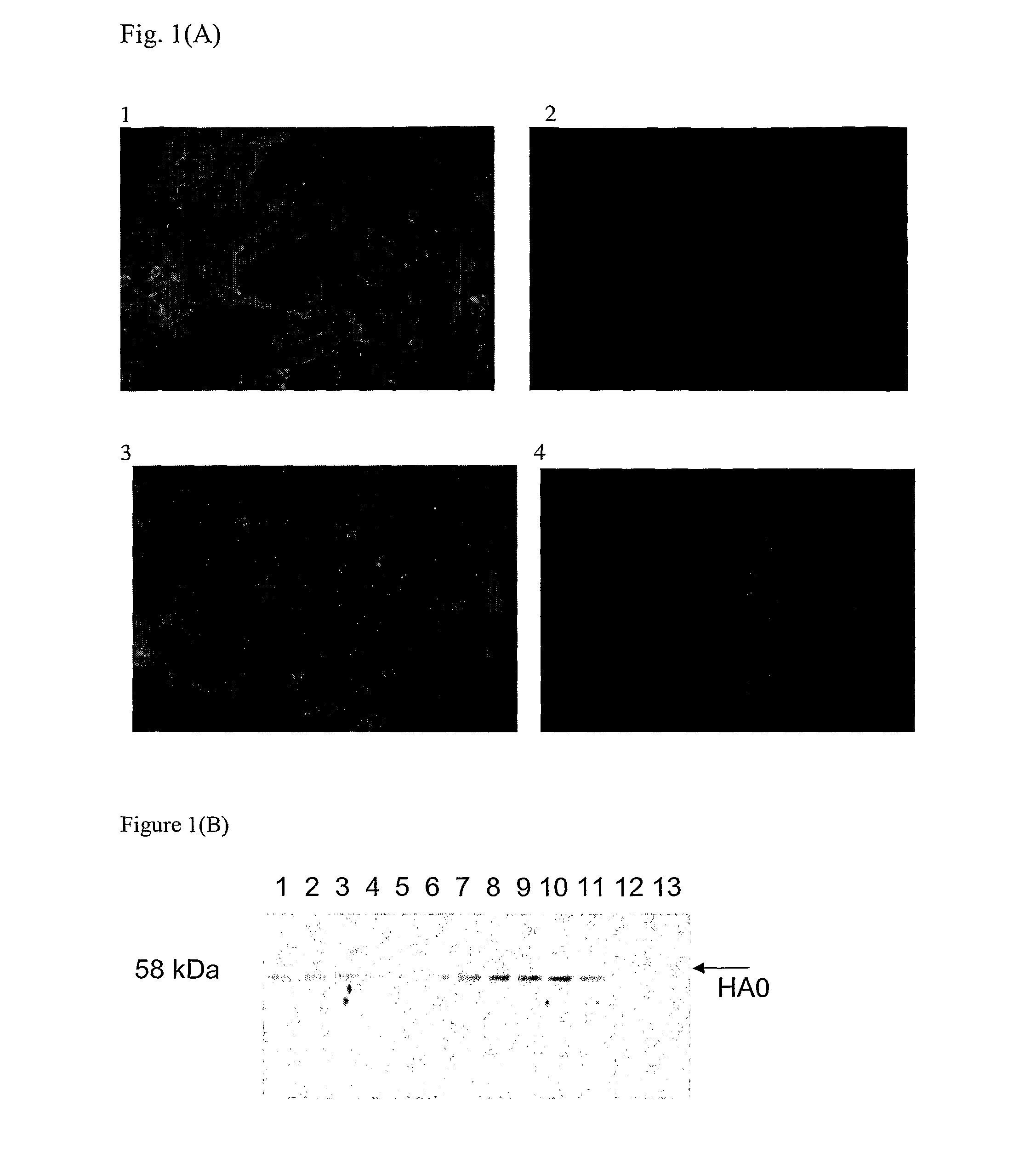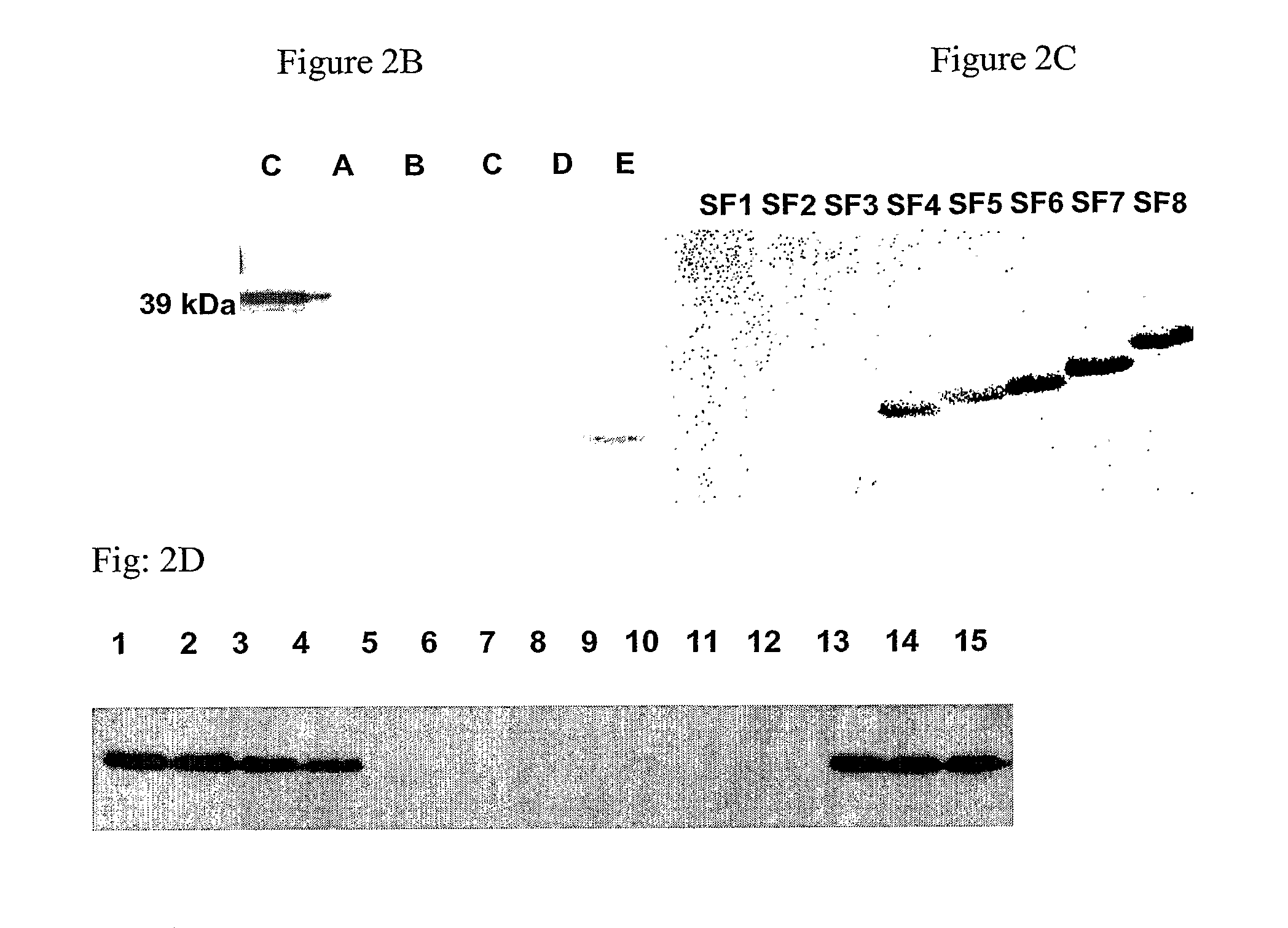Binding protein and epitope-blocking ELISA for the universal detection of H5-subtype influenza viruses
a technology of h5-subtype influenza viruses and binding proteins, which is applied in the field of specific serological assays, can solve the problems of loss affecting the income of millions of people, limited use to clinicians, and loss of millions of dollars in poultry industry, and achieves stable and high-antigenic effects
- Summary
- Abstract
- Description
- Claims
- Application Information
AI Technical Summary
Benefits of technology
Problems solved by technology
Method used
Image
Examples
example 1
I. Experimental
Viruses
[0053]Twenty four isolates of Indonesian H5N1 influenza strains used in this study and listed in Table 1 below (entries 1-24) were obtained from the National Institute of Health, Research and Development, Indonesia. Other H5 and non-H5 subtypes were provided by the Agri-Food and Veterinary Authority (AVA) of Singapore (entries 25-31 of Table 1).
[0054]
TABLE 1The avian influenza viruses used in this experimentSerial No.VirusesSubtypes1.Human / Indonesia / CDC7 / 06*H5N12.Human / Indonesia / CDC326 / 06*H5N13.Human / Indonesia / CDC329 / 06*H5N14.Human / Indonesia / CDC370 / 06*H5N15.Human / Indonesia / CDC390 / 06*H5N16.Human / Indonesia / CDC523 / 06*H5N17.Human / Indonesia / CDC594 / 06*H5N18.Human / Indonesia / CDC595 / 06*H5N19.Human / Indonesia / CDC597 / 06*H5N110.Human / Indonesia / CDC610 / 06*H5N111.Human / Indonesia / CDC623 / 06*H5N112.Human / Indonesia / CDC644 / 06*H5N113.Human / Indonesia / CDC669 / 06*H5N114.Human / Indonesia / TLL01 / 06*H5N115.Human / Indonesia / TLL02 / 06*H5N116.Duck / Indonesia / TLL60 / 06*H5N117.Human / Indonesia / TLL177 / ...
example 2
I. Experimental
[0083]A second monoclonal antibody, designated 1G5, was generated following the general procedures of Example 1 to obtain hybridoma supernatant. The mAb was raised against the recombinant HA0 protein, cloned from H5N1 influenza virus strain A / goose / Guangdong / 97.
Immunofluorescence Assay (IFA)
[0084]Sf-9 and MDCK cells were seeded in 960 well plates and incubated with recombinant baculovirus harboring truncated H5N1 HA1 gene and H5N1 viruses, respectively, At 36 hours post-infection, the cells were fixed with 4% paraformaldehyde for 30 minutes at room temperature. All washes were performed with PBS, pH 7.4. Fixed cells were incubated with hybridoma culture fluid at 37° C. for 1 hour, washed and incubated with a 1:50 dilution of fluorescein isothiocyanate (FITC)-conjugated rabbit anti-mouse Ig. Cells were washed and fluorescence was visualized using an Olympus IX71 microscope with appropriate barrier and excitation filters.
[0085]One mAb, designated 1G5, determined to be a...
example 3
Development of Antigen Capture ELISA (AC-ELISA)
[0101]96-well plates (Nunc, Denmark) were coated with purified mAbs 5F8 and / or 1G5 in 50 μl carbonate buffer (73 mM sodium bicarbonate and 30 mM sodium carbonate) and incubated at 37° C. for 1 hour or at 4° C. overnight. After each incubation step, the plates were washed 3 times with PBS containing 0.05% Tween 20 (PBST), and all dilutions were made in PBST containing 1% non-fat milk. The plates were blocked by incubation with 100 μl of blocking solution (5% non-fat milk in PBS-T at 37° C. for 1 hour, rinsed and incubated with 50 μl of purified highly pathogenic H5N1 Indonesian strains / low pathogenic AIV H5 subtypes (H5N1 / PR8, H5N2 and H5N3) / other non-H5 subtypes at 37° C. for 1 hour. After rinsing, 100 μl of guinea pig monospecific antibody IgG (1:500 dilution) were added, incubated for 1 hour at 37° C., washed and further incubated with 100 μl of HRP-conjugated rabbit anti-guinea pig immunoglobulin (diluted 1:1000). Color development w...
PUM
| Property | Measurement | Unit |
|---|---|---|
| volume | aaaaa | aaaaa |
| pH | aaaaa | aaaaa |
| size | aaaaa | aaaaa |
Abstract
Description
Claims
Application Information
 Login to View More
Login to View More - R&D
- Intellectual Property
- Life Sciences
- Materials
- Tech Scout
- Unparalleled Data Quality
- Higher Quality Content
- 60% Fewer Hallucinations
Browse by: Latest US Patents, China's latest patents, Technical Efficacy Thesaurus, Application Domain, Technology Topic, Popular Technical Reports.
© 2025 PatSnap. All rights reserved.Legal|Privacy policy|Modern Slavery Act Transparency Statement|Sitemap|About US| Contact US: help@patsnap.com



